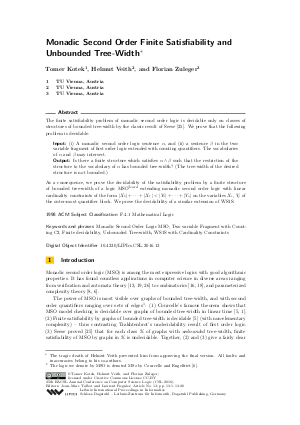Monadic Second Order Finite Satisfiability and Unbounded Tree-Width
Authors Tomer Kotek, Helmut Veith, Florian Zuleger
-
Part of:
Volume:
25th EACSL Annual Conference on Computer Science Logic (CSL 2016)
Part of: Series: Leibniz International Proceedings in Informatics (LIPIcs)
Part of: Conference: Computer Science Logic (CSL) - License:
 Creative Commons Attribution 3.0 Unported license
Creative Commons Attribution 3.0 Unported license
- Publication Date: 2016-08-29
File

PDF
LIPIcs.CSL.2016.13.pdf
- Filesize: 0.61 MB
- 20 pages
Document Identifiers
Subject Classification
Keywords
- Monadic Second Order Logic MSO
- Two variable Fragment with Counting C2
- Finite decidability
- Unbounded Tree-width
- WS1S with Cardinality Constraints
Metrics
- Access Statistics
-
Total Accesses (updated on a weekly basis)
0PDF Downloads0Metadata Views
Abstract
The finite satisfiability problem of monadic second order logic is decidable only on classes of structures of bounded tree-width by the classic result of Seese. We prove that the following problem is decidable:
Input: (i) A monadic second order logic sentence alpha, and (ii) a sentence beta in the two-variable fragment of first order logic extended with counting quantifiers. The vocabularies of alpha and beta may intersect.
Output: Is there a finite structure which satisfies alpha and beta such that the restriction of the structure to the vocabulary of alpha has bounded tree-width? (The tree-width of the desired structure is not bounded.)
As a consequence, we prove the decidability of the satisfiability problem by a finite structure of bounded tree-width of a logic MS^{exists card} extending monadic second order logic with linear cardinality constraints of the form |X_{1}|+...+|X_{r}| < |Y_{1}|+...+|Y_{s}| on the variables X_i, Y_j of the outer-most quantifier block. We prove the decidability of a similar extension of WS1S.
Cite As Get BibTex
Tomer Kotek, Helmut Veith, and Florian Zuleger. Monadic Second Order Finite Satisfiability and Unbounded Tree-Width. In 25th EACSL Annual Conference on Computer Science Logic (CSL 2016). Leibniz International Proceedings in Informatics (LIPIcs), Volume 62, pp. 13:1-13:20, Schloss Dagstuhl – Leibniz-Zentrum für Informatik (2016)
https://doi.org/10.4230/LIPIcs.CSL.2016.13
BibTex
@InProceedings{kotek_et_al:LIPIcs.CSL.2016.13,
author = {Kotek, Tomer and Veith, Helmut and Zuleger, Florian},
title = {{Monadic Second Order Finite Satisfiability and Unbounded Tree-Width}},
booktitle = {25th EACSL Annual Conference on Computer Science Logic (CSL 2016)},
pages = {13:1--13:20},
series = {Leibniz International Proceedings in Informatics (LIPIcs)},
ISBN = {978-3-95977-022-4},
ISSN = {1868-8969},
year = {2016},
volume = {62},
editor = {Talbot, Jean-Marc and Regnier, Laurent},
publisher = {Schloss Dagstuhl -- Leibniz-Zentrum f{\"u}r Informatik},
address = {Dagstuhl, Germany},
URL = {https://drops.dagstuhl.de/entities/document/10.4230/LIPIcs.CSL.2016.13},
URN = {urn:nbn:de:0030-drops-65537},
doi = {10.4230/LIPIcs.CSL.2016.13},
annote = {Keywords: Monadic Second Order Logic MSO, Two variable Fragment with Counting C2, Finite decidability, Unbounded Tree-width, WS1S with Cardinality Constraints}
}
Author Details
References
-
S. Arnborg, J. Lagergren, and D. Seese. Easy problems for tree-decomposable graphs. Journal of Algorithms, 12(2):308-340, 1991.

-
F. Baader, D. Calvanese, D. L. McGuinness, D. Nardi, and P. F. Patel-Schneider, editors. The Description Logic handbook. Cambridge University Press, 2003.

-
D. Calvanese, T. Kotek, M. Šimkus, H. Veith, and F. Zuleger. Shape and content. In Integrated Formal Methods, pages 3-17. Springer, 2014.

-
W. Charatonik and P. Witkowski. Two-variable logic with counting and trees. In LICS, pages 73-82. IEEE, 2013.

-
B. Courcelle. The monadic second-order logic of graphs. i. recognizable sets of finite graphs. Information and computation, 85(1):12-75, 1990.

-
B. Courcelle and J. Engelfriet. Graph structure and monadic second-order logic: a language-theoretic approach, volume 138. Cambridge University Press, 2012.

-
B. Courcelle and J. A. Makowsky. Fusion in relational structures and the verification of monadic second-order properties. Mathematical Structures in Computer Science, 12(02):203-235, 2002.

-
J. Flum and M. Grohe. Parameterized Complexity Theory. Texts in Theoretical Computer Science. Springer, 2006.

-
E. Grädel. On the restraining power of guards. The Journal of Symbolic Logic, 64(04):1719-1742, 1999.

-
E. Grädel and M. Otto. On logics with two variables. Theoretical computer science, 224(1):73-113, 1999.

-
E. Grädel, M. Otto, and E. Rosen. Two-variable logic with counting is decidable. In LICS, pages 306-317. IEEE, 1997.

-
Erich Grädel, Martin Otto, and Eric Rosen. Undecidability results on two-variable logics. In STACS 97, 14th Annual Symposium on Theoretical Aspects of Computer Science, Lübeck, Germany, February 27 - March 1, 1997, Proceedings, pages 249-260, 1997.

-
J.G. Henriksen, J. Jensen, M. Jørgensen, N. Klarlund, R. Paige, T. Rauhe, and A. Sandholm. Mona: Monadic second-order logic in practice. Springer, 1995.

-
W. Hodges. Model theory. In Encyclopedia of Mathematics and its Applications, volume 42. Cambridge University Press, 1993.

-
F. Klaedtke and H. Rueß. Monadic second-order logics with cardinalities. In Automata, Languages and Programming, pages 681-696. Springer, 2003.

-
T. Kotek and J. A. Makowsky. Connection matrices and the definability of graph parameters. Logical Methods in Computer Science, 10(4), 2014.

-
T. Kotek, M. Simkus, H. Veith, and F. Zuleger. Extending ALCQIO with trees. In Logic in Computer Science LICS, pages 511-522, 2015.

-
L. Lovász. Large networks and graph limits, volume 60. AMS, 2012.

-
P. Madhusudan, P. S. Thiagarajan, and Shaofa Yang. The MSO theory of connectedly communicating processes. In FSTTCS, pages 201-212, 2005.

-
J.A. Makowsky. Algorithmic uses of the Feferman-Vaught theorem. Annals of Pure and Applied Logic, 126(1):159-213, 2004.

-
G. Nelson and D.C. Oppen. Simplification by cooperating decision procedures. TOPLAS, 1(2):245-257, 1979.

-
A. Pnueli. The temporal logic of programs. In FOCS, pages 46-57. IEEE, 1977.

-
I. Pratt-Hartmann. Complexity of the two-variable fragment with counting quantifiers. Journal of Logic, Language and Information, 14(3):369-395, 2005.

-
A.J.A. Robinson and A. Voronkov. Handbook of automated reasoning. Elsevier, 2001.

-
D. Seese. The structure of the models of decidable monadic theories of graphs. Annals of pure and applied logic, 53(2):169-195, 1991.

-
W. Thomas. Languages, automata, and logic. Springer, 1997.

-
M.Y. Vardi. Why is modal logic so robustly decidable? Descriptive complexity and finite models, 31:149-184, 1996.

